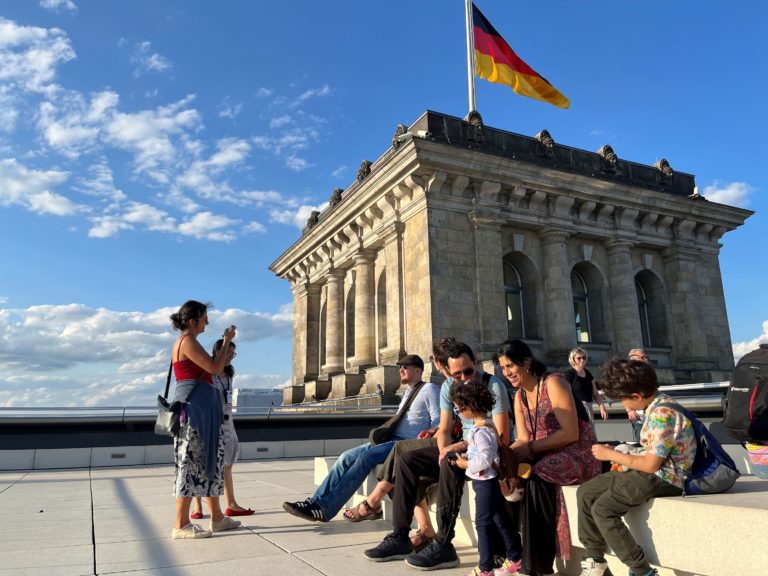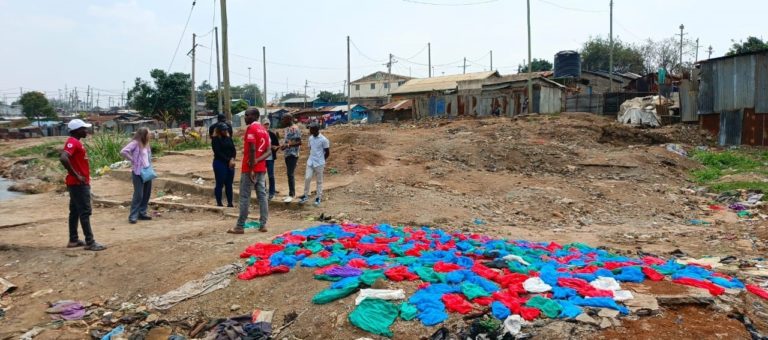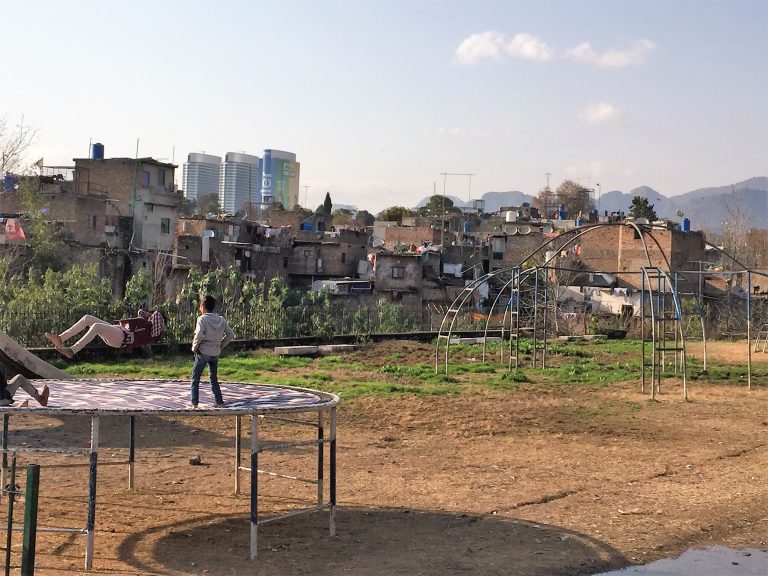Water and sanitation for all? About the challenges of providing access to drinkable water in Niger
The United Nations Sustainable Development Goal (SDG) number 6 targets: “Ensure availability and sustainable management of water and sanitation for all”. But what are the challenges on the ground in rural West Africa?
Lémonla Armel Otekpo, a master student in the DAAD-funded and ZEF-run project «West African Center for Sustainable Rural Transformation» (WAC-SRT) and Segbedji Geraldo Favi, a former student in the same program and now a PhD student at the Abdou Moumouni University of Niamey, Niger, have been looking into these challenges during their research ‘in the field’. Read about their amazing one-day road trip to two remote villages in Niger’s desert. Both authors are also members of the Climate-and-Sustainable-Development-Actions-Club.
“We can learn a lot by reading, but it is always good to confront reality and have experiences from the ground. With this logic, we had the opportunity to touch with our finger the challenges related to access to drinking water faced by the people located in semi-desert areas. This trip was rich in experience and emotion because we visited localities for the first time that are not connected to the national water distribution system of the Société d’Exploitation des Eaux du Niger”.
Lémonla Armel Otekpo and Segbedji Geraldo Favi (in the right photo below)

Niger: poor rural population with poor access to water
Niger is a developing country located in West Africa between the Equator and the Tropic of Cancer. The country covers a total area of 1,266,700 km2 with a total population of 24,206,636 in 2020 [world bank data[1]]. The country has a density of 19.11 inhabitants per km2, with about 17% of the population living in urban areas and 83% in rural ones[2], [3]. Only 56% of the population has access to a safe water source, mainly in urban areas, and 22.7% of schools have access to safe water [4].
Populations without access to safe water sources are at high risk of contracting water-related diseases which therefore pose the major cause of death in children under five. Niger’s rural livelihoods are mainly agriculture-based. The main agricultural activities are rain-fed, and the progressive decline in agricultural yields, exacerbated by the scarcity of rainfall due to climate change and variability, is significantly affecting the country’s food production. As a result, food insecurity is increasing.
On the road to the village of Djami, our first destination
The goal of our field trip was to look into water-access related issues in Niger’s rural areas. We selected two villages in different regions with similar basic needs, such as water and energy challenges: Djami and Dar es salaam. In Djami we wanted to repair a solar-driven water pumping system, and in Dar es salaam we wanted to collect data.
Djami, is located 140 km northwest of the capital Niamey, in the rural commune of Imanan, in the region of Tillabéry (department of Filingué). We took a taxi from Niamey and after a 4-hour drive we arrived in Bonkoukou, the main town of the rural commune (canton) of Imanan (see figure 1).

From Bonkoukou we headed to Djami, which is another 7-kilometer and 45-minute journey. This time we traveled on a cart guided by a man tying a black scarf on his head, thus adapting personally to the climate. We could feel the intensity of the heat. The mercury rises above 46°C under an incandescent sun that shines at the zenith and as far as the horizon can see in this region of Niger. The region remains desperately dry.
Since this region is a so-called ‘red zone’ (prone to terrorist attacks), no motorized two-wheeled transport means are allowed into the area until further notice. The most used means of transport in this part of Niger is therefore carts pulled by an ox or a donkey, or simply on foot. We, therefore, moved with the ox-pulled cart while enjoying the landscape. The road was still a long stretch to go. We could see other passers-by, women and children moving slowly, on the backs of donkeys already overloaded with jute bags, plastic jerry cans, mats and calabashes. In addition, an endless procession of cattle, sheep, goats and camels is heading north.
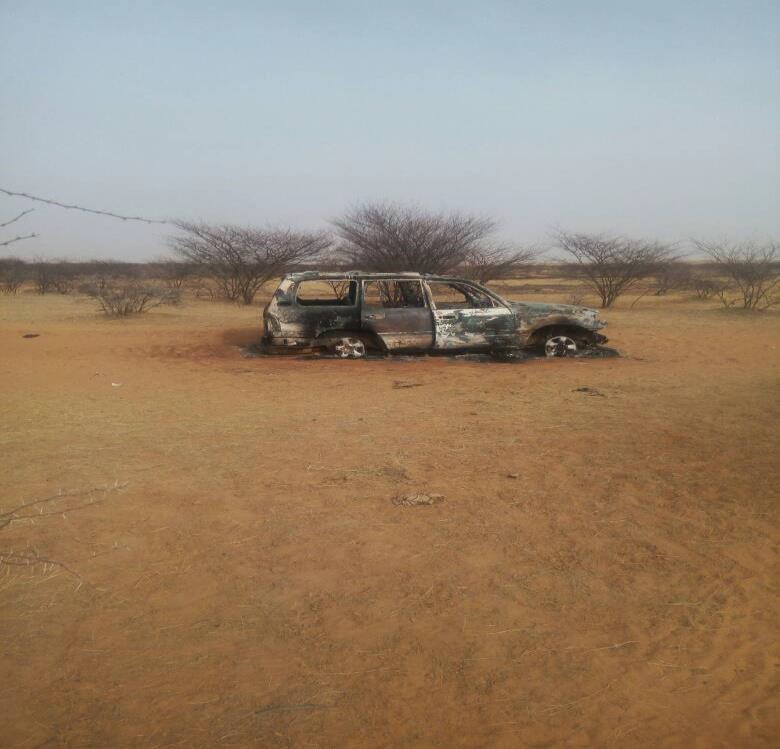
One can see that everyone here lives on their reserves and the animals, stunted, seem exhausted. Having an animal, especially an ox represents much more than a source of income.
“An ox is the symbol of freedom”, says the guide. Alongside the cows, humans can free themselves from borders and travel the world. Moreover, among the Fulani tribe, one of the largest ethnic groups in the Sahel and West Africa consisting mainly of pastoralists, the cow is said to be the origin of the creation of life. Gueno (God) the eternal gives it a form from a drop of milk.
After 46 minutes on the cart, in the middle of a windswept plain with plastic bags clinging to the thorny trees, we can see some tiny houses indicating our destination, the village of Djami. The plastic pollution has also arrived there! We wonder.
Arriving in Djami …
We barely got off the cart and were thirsty. However, the quality of the water served left much to be desired.

This water coming from an artisanal well was served to us because the water pumping system was out of service. We were lucky enough to have bought ice in Bonkoukou. We refreshed ourselves despite the very questionable quality of the water, before starting the work that brought us here, which is nothing less than the repair of the water pumping system that had been out of order for several days.
The primary sources of income of this rural community are agriculture, livestock and small-scale irrigated horticulture. Water for horticulture irrigation is mainly pumped or fetched respectively by diesel engines, or electric pumps driven by a diesel generator and hand pumping.
…and seeing the impacts of climate change face-to-face
“The village is experiencing strong social dynamics due to climatic challenges, with recurrent droughts (huge variability in rainfall), causing stress on food availability. This situation, exacerbated by growing insecurity and the fight against jihadist groups across the country, is leading to significant population out-migration. The houses are very far apart, and it is difficult to see the way when you are called for assistance”.
Hands-on: Repairing a sustainable drinking water system in Djami
This drinking water pumping system, run with solar panels, is used to supply the surrounding population with safe drinking water and also allows the irrigation of about 2 hectares of horticulture.
The solar water pumping system was installed by the ZEF-led CIREG (Climate Information for Integrated Renewable Electricity Generation) project as a demonstrator of the application of solar photovoltaics for irrigation. It should be noted that access to drinking water is a challenge due to geomorphological constraints, with a deep water table difficult to access in the region.
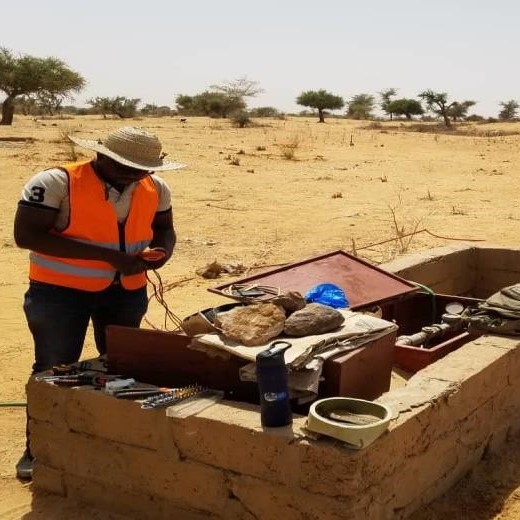

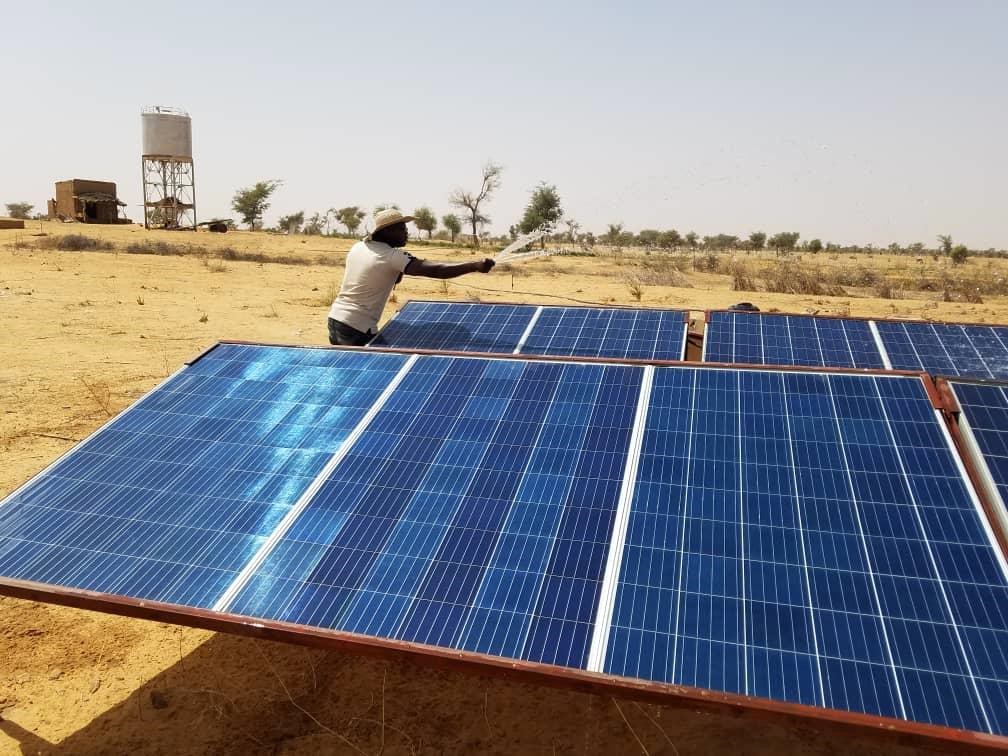

The pump’s circuit breaker and regulator were found to be defective, which stopped the electrical box from working. We replaced the damaged parts and cleaned the solar panels. The managers of hydraulic works are not trained to deal with the various technical breakdowns that can occur. While waiting for the sunset, we are happy to have saved lives by contributing to the troubleshooting water system. (See photos above text).
Dar es salaam. A similar story about poor access to water
Dar-es-salam, the second village we visited, is located 72 km northeast of Niger’s capital Niamey and part of the rural municipality of Ngonga, Dosso region (Figure 2). The region has approximately 4,700 inhabitants living in 750 households. Their main economic activity is agriculture (millet, sorghum and peanuts) and livestock. One of the main impacts of climate change is that precipitation has become more variable, and the rainy seasons have become shorter. As a result, many people in rural areas are leaving their villages during the (agricultural) off-season or diversify their income through alternative business activities including wood selling.
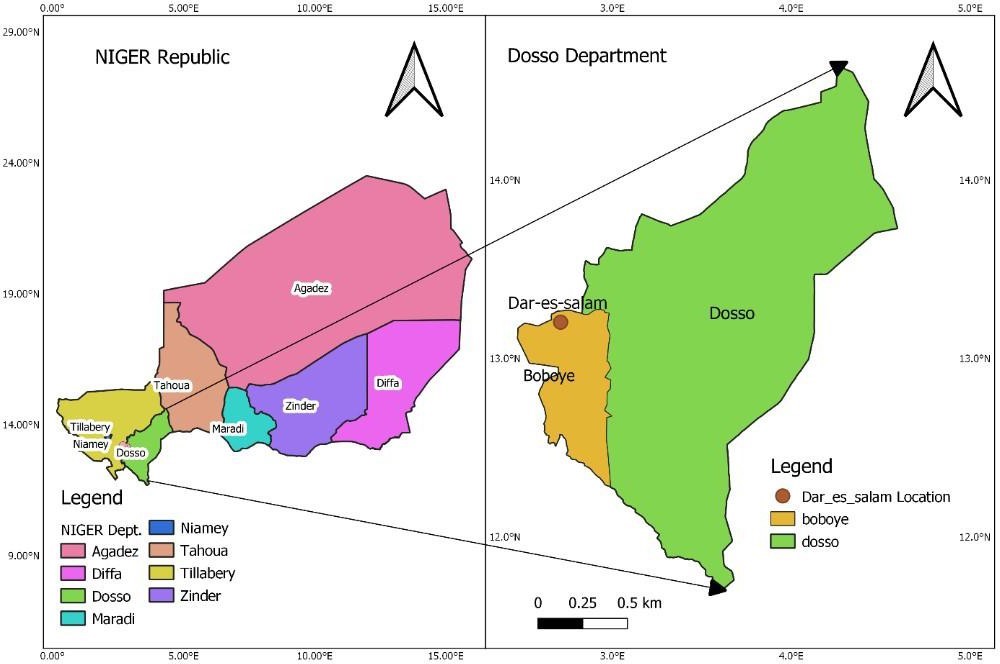
The observation regarding access to water here in Dar es Salaam remains the same as in Djami, the previous village we visited. One can see in the photo that the women of Dar es salaam spend most of the day fetching water for their households. In addition, they still rely on traditional traction with donkeys to withdraw water from open wells of uncertain quality (see pictures below).
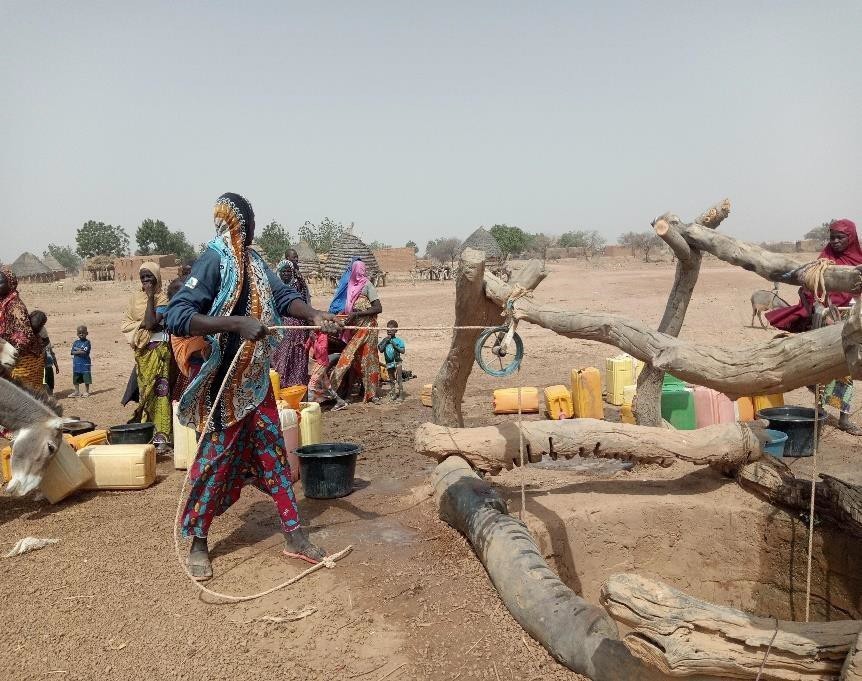
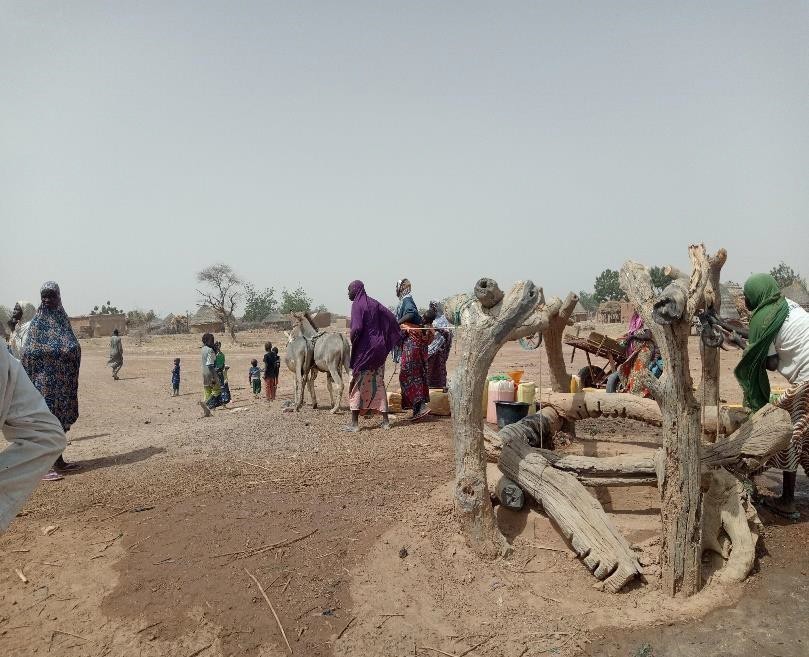
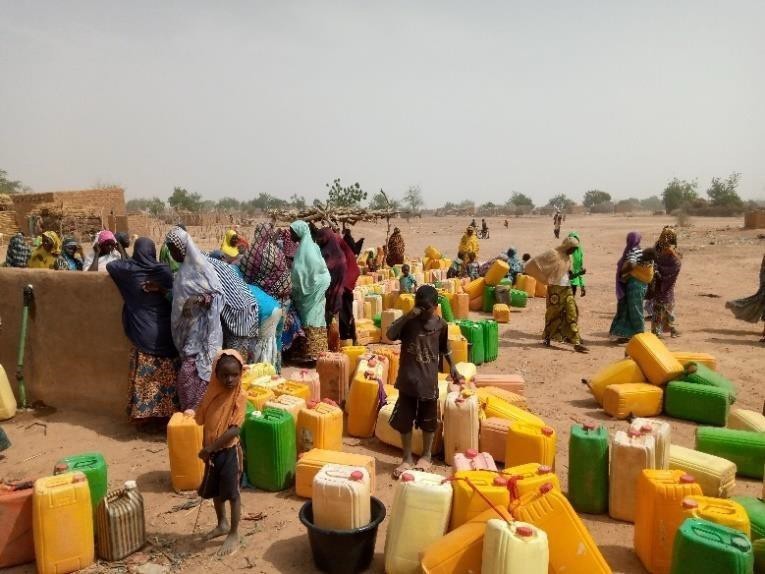
The challenges faced by rural areas in Niger are therefore not only having access to water but also having access to clean and potable water. People’s livelihoods are dependent on water to a large extent. However, due to the impact of climate change, people in rural areas will have to walk further and further to have access to water resources or chase clouds and wait for rain. The photos above clearly show the challenges of achieving Sustainable Development Goal 6 in remote rural areas of Niger.
Governance at the heart of weak service delivery
Water management is a fundamental component in the process of generating any sustainable socio-economic development project or program. In rural areas, the total needs of drinking water are met from groundwater, the exploitation of which requires a lot of financial and material means, hence the difficulty encountered by the populations (World Bank 2019).
«The low and uneven distribution of WASH services is rooted in the deep water governance and policy in Niger, where the political economy does not prioritize public service delivery. Indeed, while Niger has made significant progress in its WASH policy and legal framework over the past years, the water sector has remained constrained by three (03) major governance challenges:
- Institutional fragmentation and lack of coordination in the sector
- Uneven distribution of funding across sub-sectors, low absorptive capacity, and a lack of prioritization of poverty reduction in the long term.
- Recent and effective decentralization of water responsibilities to local governments, lack of financial and human capacity to respond to water service delivery challenges“.
[Source of quoted previous passage: World Bank. 2019. A Destiny Shaped by Water: Diagnosing Access to Water, Sanitation, Hygiene (WASH), and Poverty in Niger. World Bank, Washington, DC.]
Our personal resumé
After our trip to these two remote villages, we can confirm, with evidence, that access to safe drinking water, SDG goal 6, remains an urgent challenge in some rural areas of Niger.
This despite efforts undertaken by the government and NGOs to improve the situation. In addition, looking at the devastating impacts of climate change on natural resources, we think it is necessary to call for prudent action, not from specific institutions and agencies but individuals, especially the youth. Therefore every little action can help make a change. It is against this background that we resolved to address some of the above challenges using our ability and skills to design, install and maintain solar pumping systems for domestic use and crop production as well as training youth to do so. In addition, we help raise awareness about climate change mitigation and adaptation across Niger through the Climate-and-Sustainable-Development-Actions-Club.
“Our goal and hope is to contribute with science to change the picture of climate-change related issues in Niger”.
Authors:
| Segbedji Geraldo FAVI PhD Candidate in Climate change and Energy Nexus / Water-Energy-Food nexus Researcher and Engineer E-mail: favi.segbedji@yahoo.com WhAp: +491781398073/ Tel:+22791953691 www.linkedin.com/in/segbedji-geraldo-favi-160168196/ |
Lémonla Armel OTEKPO MSc Rural Development Strategy & Policy (Water-Energy-Agriculture) / West African German Center-Sustainable Rural Transformation (WAC-SRT) / Abdou Moumouni University Niamey (NIGER) / E-mail: otekpoarmel91@yahoo.fr /www.researchgate.net/profile/Lemonla-Armel-otekpo / www.linkedin.com/in/armel-lémonla-otekpo-81163842 / ORCIDE: https://orcid.org/0000-0003-2281-4577 / Tel: +227 92 52 45 54 / +229 66 89 79 97
References
[1] “Population, total – Niger | Data.” [Online]. Available: https://data.worldbank.org/indicator/SP.POP.TOTL?locations=NE. [Accessed: 18-Nov-2021].
[2] “Population density (people per sq. km of land area) – Niger | Data.” [Online]. Available: https://data.worldbank.org/indicator/EN.POP.DNST?locations=NE. [Accessed: 18-Nov-2021].
[3] “Niger Facts | Britannica.” [Online]. Available: https://www.britannica.com/facts/Niger. [Accessed: 18-Nov-2021].
[4] “Water, Sanitation and Hygiene | UNICEF Niger.” [Online]. Available: https://www.unicef.org/niger/water-sanitation-and-hygiene. [Accessed: 19-Mar-2021].
